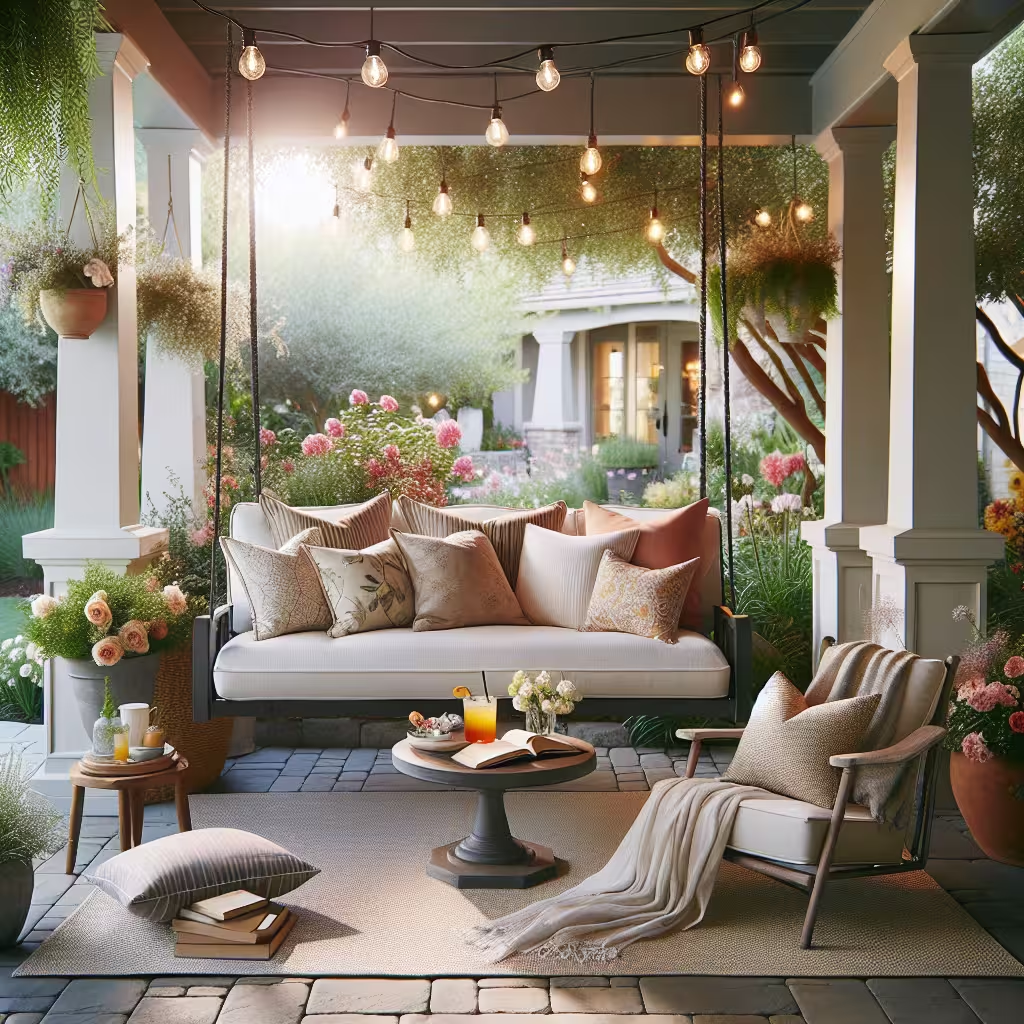Porch swings have always held a special place in our hearts, offering more than just a seat outdoors. They provide a sanctuary for relaxation, a space for connection, and a bridge between our homes and the world beyond. As someone who has spent countless hours researching and experiencing the joy of porch swings, I’ve come to appreciate their profound impact on our well-being. These simple structures fulfill our innate needs for comfort, belonging, and a sense of place. By choosing the right porch swing, we’re not just adding furniture to our homes; we’re creating opportunities for rest, reflection, and meaningful interactions with loved ones and nature.
Reader Disclosure
Jump to:
Understanding Porch Swings
Types of Porch Swings
Porch swings come in various styles and materials, each offering unique benefits:
- Traditional Wooden Swings: Classic and timeless, wooden swings blend seamlessly with most architectural styles. They’re often made from durable hardwoods like cedar, teak, or cypress.
- Metal Swings: Typically constructed from wrought iron or aluminum, metal swings offer durability and a sleek, modern appearance.
- Wicker or Rattan Swings: These swings provide a casual, coastal feel and are lightweight yet sturdy.
- Plastic or Resin Swings: Low-maintenance and weather-resistant, these swings are ideal for harsh climates.
- Fabric or Rope Swings: Offering a bohemian or rustic charm, these swings are perfect for a relaxed, informal setting.
Key Features to Consider
When selecting a porch swing, keep these essential features in mind:
Size and Weight Capacity
Porch swings typically range from 4 to 6 feet in width. Consider the available space on your porch and the number of people you’d like to accommodate. Here’s a general guide:
| Swing Width | Ideal For | Typical Weight Capacity |
|---|---|---|
| 4 feet | 1-2 adults | 400-500 lbs |
| 5 feet | 2-3 adults | 500-600 lbs |
| 6 feet | 3-4 adults | 600-800 lbs |
Material and Durability
The material of your porch swing affects its longevity, maintenance requirements, and overall aesthetic. Here’s a comparison:
| Material | Durability | Maintenance | Weather Resistance |
|---|---|---|---|
| Wood | High | Moderate | Varies (needs treatment) |
| Metal | Very High | Low | High |
| Wicker/Rattan | Moderate | Moderate | Moderate |
| Plastic/Resin | High | Very Low | Very High |
Comfort and Ergonomics
A comfortable porch swing should have:
- A seat depth of 18-22 inches
- A backrest angle of 100-110 degrees
- Adequate lumbar support
- Optional cushions or pillows for added comfort
Style and Aesthetics
Choose a swing that complements your home’s architecture and your personal taste. Consider factors like color, design, and decorative elements.
Installation and Safety
Ensure your porch can support the weight of the swing and its occupants. Professional installation is recommended for safety. Key safety features include:
- Sturdy chains or ropes
- Secure mounting hardware
- Non-slip seat surface
- Smooth, rounded edges

Choosing the Right Porch Swing
Assessing Your Space
Before purchasing a porch swing, carefully measure your porch area. Consider these factors:
- Available space: Measure the width and depth of your porch, accounting for any existing furniture or fixtures.
- Ceiling height: Ensure there’s enough clearance for the swing and its occupants. A minimum of 7 feet is recommended.
- Swing arc: Allow at least 3-4 feet of clearance in front and behind the swing for a comfortable range of motion.
- Support structure: Verify that your porch ceiling can support the weight of the swing and its occupants. Consult a professional if unsure.
Matching Your Home’s Style
Your porch swing should complement your home’s architectural style and outdoor decor. Here are some suggestions:
- Traditional homes: Opt for classic wooden swings with simple, elegant designs.
- Modern homes: Consider sleek metal or minimalist wooden swings with clean lines.
- Coastal or beach houses: Wicker or weathered wood swings create a relaxed, beachy vibe.
- Rustic or country homes: Look for swings made from reclaimed wood or with a distressed finish.
- Eclectic or bohemian styles: Explore unique designs like macramé or colorful fabric swings.
Considering Climate and Weather
Your local climate plays a crucial role in selecting the right porch swing material:
- Humid climates: Choose rot-resistant woods like cedar or teak, or opt for metal or plastic swings.
- Coastal areas: Look for corrosion-resistant materials like aluminum or specially treated woods.
- Sunny regions: Consider UV-resistant materials to prevent fading and deterioration.
- Cold climates: Ensure the swing can withstand freezing temperatures and potential snow load.
Budgeting for Your Porch Swing
Porch swings vary widely in price, depending on materials, size, and craftsmanship. Here’s a general price range to help you budget:
Remember to factor in additional costs such as cushions, installation hardware, and professional installation if required.
Maintenance and Care
Proper maintenance ensures your porch swing remains safe, comfortable, and visually appealing for years to come. Here are some tips:
- Regular cleaning: Clean your swing at least once a month with a mild soap solution and soft brush. Rinse thoroughly and allow to dry completely.
- Protective treatments: Apply appropriate sealants or finishes to wooden swings annually to protect against moisture and UV damage.
- Hardware inspection: Check chains, hooks, and other hardware for signs of wear or corrosion every few months. Replace as needed.
- Cushion care: Store cushions indoors when not in use or during inclement weather to prevent mold and mildew growth.
- Winter storage: In harsh climates, consider storing your swing indoors during winter months to protect it from snow and freezing temperatures.
- Lubrication: Apply a silicone-based lubricant to swing mechanisms annually to ensure smooth operation.
Enhancing Your Porch Swing Experience
To maximize enjoyment of your porch swing, consider these enhancements:
- Cushions and pillows: Add comfort and style with weather-resistant cushions and decorative pillows.
- Lighting: Install ambient lighting like string lights or lanterns to create a cozy atmosphere for evening relaxation.
- Side tables: Place small tables on either side of the swing for convenient drink or book placement.
- Planters: Surround your swing with potted plants to create a lush, natural environment.
- Canopy or pergola: Install a overhead structure for added shade and privacy.
- Outdoor rugs: Define the swing area and add comfort underfoot with a weather-resistant rug.

People Also Ask
How much weight can a porch swing hold?
Most porch swings can support between 400 to 800 pounds, depending on their size and construction. Always check the manufacturer’s specifications for the exact weight capacity of your chosen swing.
How high should a porch swing be off the ground?
The ideal height for a porch swing is about 17-19 inches from the floor to the top of the seat. This allows most adults to sit comfortably with their feet touching the ground.
Can I install a porch swing myself?
While it’s possible to install a porch swing yourself, it’s recommended to hire a professional to ensure proper and safe installation, especially if you’re unsure about your porch’s structural integrity.
Conclusion
Selecting the perfect porch swing is a delightful journey that combines practical considerations with personal style. By carefully assessing your space, climate, and preferences, you can choose a swing that not only enhances your home’s curb appeal but also provides a cherished spot for relaxation and connection. Remember, a porch swing is more than just furniture; it’s an investment in your home and well-being, offering countless moments of joy and tranquility for years to come.
Show & Tell
We’d love to hear your thoughts about these ideas! Simply click the link to head over to your favorite platform and add your comments about this post there. We’d like to know about your insights, questions, or just saying hi.
Disclosure
Our content is reader-supported. This means if you click on some of our links, then we may earn a commission. Commissions do not affect our editor’s opinions or evaluations. Learn more about our editorial process.

About the Editorial Staff
The Curvspace editorial team comprises a diverse group of experts on intermediate and threshold spaces in homes and workplaces. Architects and interior designers, civil engineers and artists, environmental and behavioral psychologists, sociologists and anthropologists. All collaborate to create helpful content, that explores the full potential of these often-overlooked areas to enhance our daily lives.

